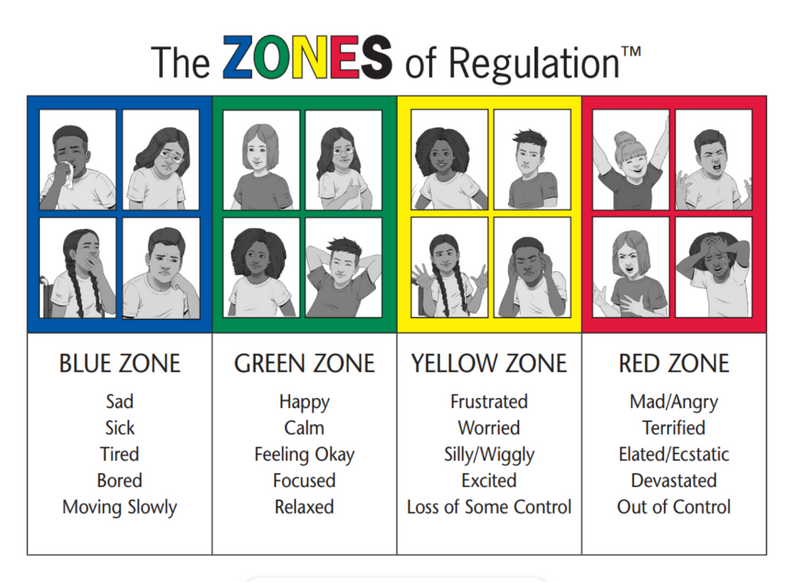Zones of Regulation
There are times when all of us (including adults) find it hard to manage strong feelings such as worry, anger, fear or tiredness, and this stops us from getting on with our day effectively. Children who feel these emotions often find it hard to learn and concentrate in school. The Zones of Regulation is a programme which aims to teach children strategies to help them cope with these feelings so they can get back to feeling calm and ready to learn. These coping strategies are called ‘self-regulation’.
At Lower Wortley Primary School, we refer to the Zones of Regulation throughout the whole school. We want to teach all of our children good coping and regulation strategies so they can help themselves when they experience anxiety and stress. The information on this page gives details about the Zones of Regulation approach that we use in school.
Understanding the zones
The Zones of Regulation programme teaches self-regulation by categorising all the different ways we feel and the states of alertness we experience into four coloured zones. Children learn to identify their feelings/level of alertness and understand how their behaviour in those states impacts those around them.
Blue Zone
This is where you would be if you are feeling:
- tired
- sad
- bored
- sick.
In this zone you are feeling slow and are mostly feeling uncomfortable.
Green Zone
This is where you feel:
- happy
- pleased
- proud
- content
- calm
- ready to learn.
This is the ideal zone for children to be in when in class - feeling comfortable.
Yellow zone
This is when ...
- there is some loss of control
- you may feel worried
- scared
- frustrated
- you behave in a silly way
- you be overly excited.
In this zone you are in a heightened state which might be either comfortable or uncomfortable.
Red Zone
This is when …
- there is a loss of control
- it can also be either comfortable of uncomfortable.
- You could be feeling rage
- fury
- elation
- total fear.
In this zone you are experiencing intense emotions.

The children explore these zones and learn to be able to identify which zone they are in. This is supported by all staff who reinforce the language of the zones. There are also displays about the zones in each classroom. Sometimes children can’t or don’t want to name their emotion but they can identify which zone they are in.
Children also learn that their feelings and emotions can lead to expected and unexpected behaviours and that those behaviours can have an impact on the children and adults around them. For example, if you are in the red zone and yelling at your friend it is unlikely that your friend will be in the green zone.
We also may scale the problem with the children - Does the size of the reaction match the problem? Is this really a yellow zone problem or is it more like a green zone problem?
The video below also explains more about the Zones of Regulation and some strategies that can be used:

Tools for regulating emotion
Once children understand the concept of the zones they then explore ways to help regulate themselves with the support of sensory devices, calming techniques and thinking strategies. In January 2023 to October 2024, each of our children in Key Stage 2 attended a workshop led by the Mindmate Support Team which gave them the opportunity to try out some grounding and breathing techniques.
We want to help all children recognise when they are beginning to feel uncomfortable in the yellow zone and help them to create a toolbox of ideas to help them regulate themselves.
The links below show some of the technques used in school.
At Home
You can support you child/children at home by referring to the zones when you are talking about feelings or addressing behaviours. Consider trying some of these ideas…
- Identify your own feelings using zones language in front of your child, e.g. I’m frustrated. I think I am in the yellow zone.”
- Talk about what tool you will use to be in the appropriate zone, e.g. “I need to take four deep breaths to help get me back to the green zone.”
- At times, wonder which zone your child is in , e.g. “I wonder if you are in the yellow zone at the moment, you seem a bit worried.”
- Discuss which zone a character in a film / book might be in.
- Engaging your child in discussion around zones when they are in the red zone is unlikely to be effective. You need to discuss the different zones and tools they can use when they are more regulated/calm.
- Explore which tools help your child return to the green zone, e.g. listening to relaxing music, colouring, squeezing a stress ball, breathing exercises etc.
- Regular check-ins, e.g. “How are you feeling now?” and “How can you get back to green?”
- Share how their behaviour is affecting your zone. For example, if they are in the green zone, you could comment that their behaviour is also helping you feel happy / be in the green zone.
- Put up and reference the zones visuals and tools in your home.
- Praise and encourage your child when they share which zone they are in.
In summary
The key message is that we want to help children all understand that it is OK to feel angry, be worried or feel scared and that they need to find ways to help themselves manage those uncomfortable feelings and self-regulate. This will also help them with their self-esteem and resilience.
